How to Mirror iPhone to MacBook without WiFi [4 Ways]
This guide explores four ways to mirror iPhone to MacBook without WiFi: AnyMiro, AirPlay via Peer-to-Peer, Bluetooth (AirServer), and Quick Time. Each method is provided with a clear and detailed procedure and its advantages and limitations. We recommend using AnyMiro, an efficient screen mirroring tool, as the best choice due to its efficiency and user-friendliness.
Joy Taylor | Last Updated: Oct. 08, 2024
1614 words|5minute
Want to mirror your iPhone to a MacBook but don’t have access to WiFi? No problem! Fortunately, mirroring your devices without WiFi in several ways is possible. If you need to share videos, presentations, or just your screen, you can do so using the right tools. In this article, you will find out four effective ways to mirror iPhone to MacBook without WiFi. You’ll explore how AnyMiro, AirPlay, Bluetooth with AirServer, and QuickTime work for screen mirroring. These methods are discussed with detailed guidelines to make the process easier. So, without much further ado, let’s begin to explore!
4 Ways to Mirror iPhone to MacBook without WiFi
Here are 4 best ways for how to screen mirror iPhone to MacBook without WiFi:
Way 1. Mirroring iPhone to MacBook via AnyMiro
AnyMiro is a powerful tool to elevate your screen mirroring experience. With or without Wi-Fi, this cross-platform utility makes it simple to link an iPhone to a MacBook and supports resolutions up to 4K. Thanks to its incredibly low latency, you can stream flawlessly on Twitch, YouTube, or Facebook.
AnyMiro also enhances audience engagement through real-time interaction features like live annotations, making it perfect for presentations. Content creators can capture and record key moments without color or quality loss, ensuring that every highlight is preserved. With its clean and user-friendly interface, AnyMiro truly unleashes your creativity while boosting interaction, making it an essential tool for anyone looking to enhance their streaming experience.
Key Features:
- Effortlessly capture and record live stream highlights for convenient video creation and future use.
- Experience flawless audiovisual synchronization with minimal latency, enabling uninterrupted real-time streaming.
- Engage viewers with real-time annotations, enhancing interaction during screen mirroring presentations or streams.
- Stream easily to OBS Studio, Twitch, YouTube, and more, delivering high-quality content to any platform.
Here are the steps to use AnyMiro for screen mirroring:
Step 1. Open AnyMiro on your MacBook and select “iOS/iPadOS” to start.
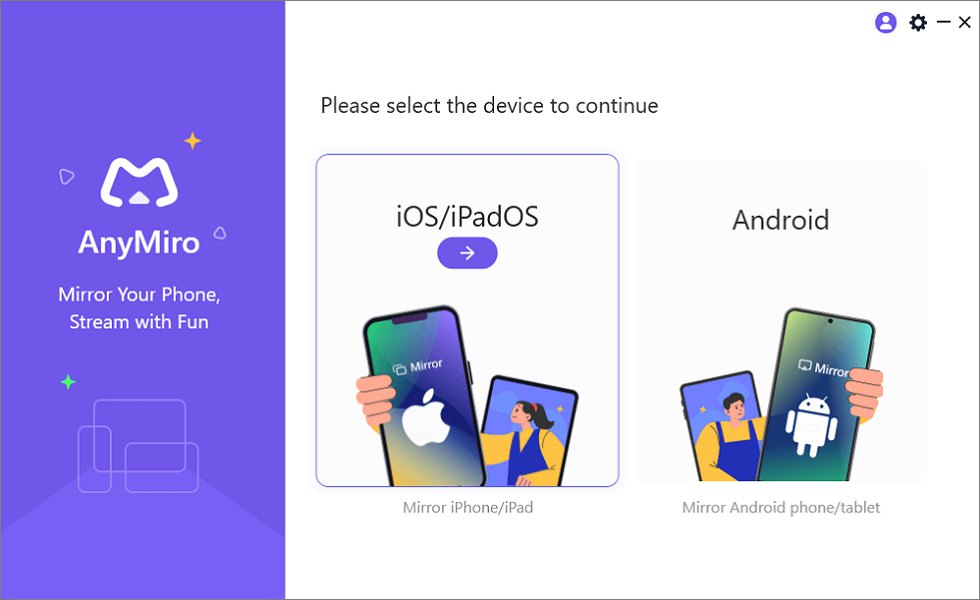
Mirror iPhone to Computer
Step 2. Choose “Wi-Fi connection” mode.
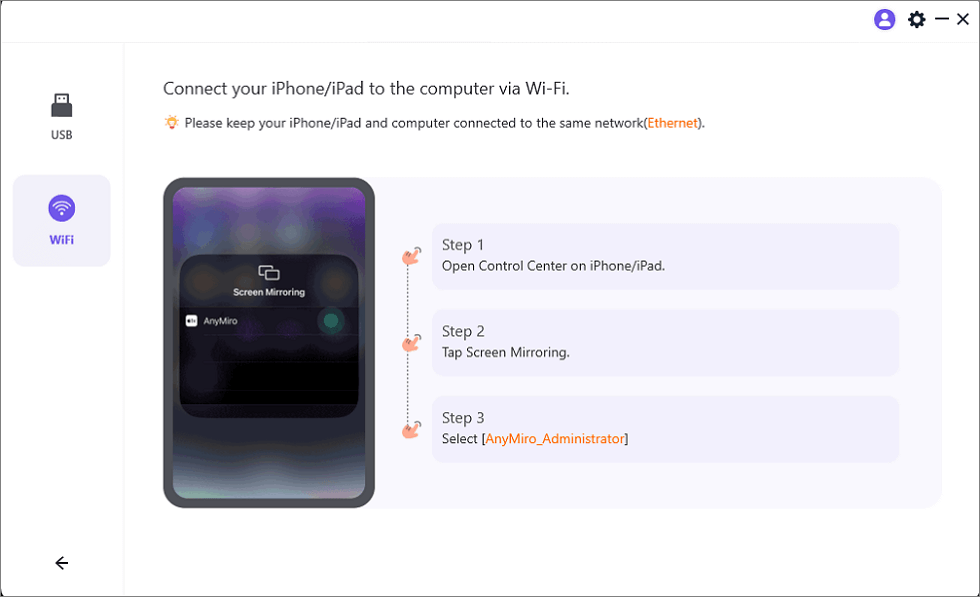
Mirror iOS to Computer via WiFi
Step 3. Your iPhone and MacBook must have the same WiFi connection. Check the Wi-Fi name in “Settings” on both devices.
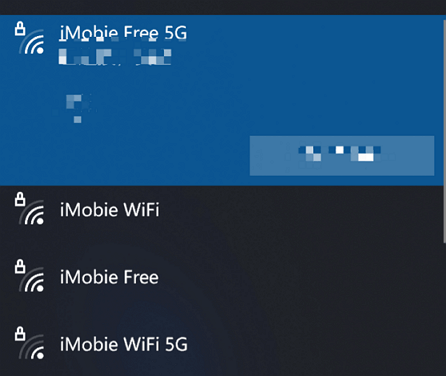
Computer and iPhone Connect to the Same WiFi
Step 4. On your iPhone, open “Control Center,” tap “Screen Mirroring,” and choose “AnyMiro_[MacBook Name]” from the list.
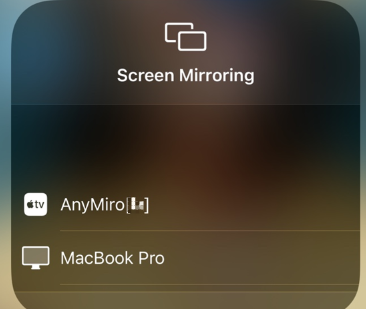
Select AnyMiro to Mirror iPhone to MacBook Bluetooth
Step 5. Your iPhone screen will now appear on your MacBook, allowing you to enjoy seamless mirroring without delay.
Way 2. Airplay iPhone to MacBook without WiFi
AirPlay enables you to mirror your iPhone to a MacBook even when you’re not connected to Wi-Fi. When Wi-Fi is spotty or unavailable, this capability comes in quite handy. Peer-to-peer AirPlay ensures a solid connection between your MacBook and iPhone by connecting them directly over Wi-Fi Direct and Bluetooth. You can enjoy smooth media and video playback with its excellent screen mirroring. You can also use audio streaming without delay, and it supports file sharing between devices. This method provides privacy and security, as it doesn’t rely on public networks. For this:
Step 1. On your MacBook, go to “System Preferences,” select “Sharing,” and click on “AirPlay Receiver.”
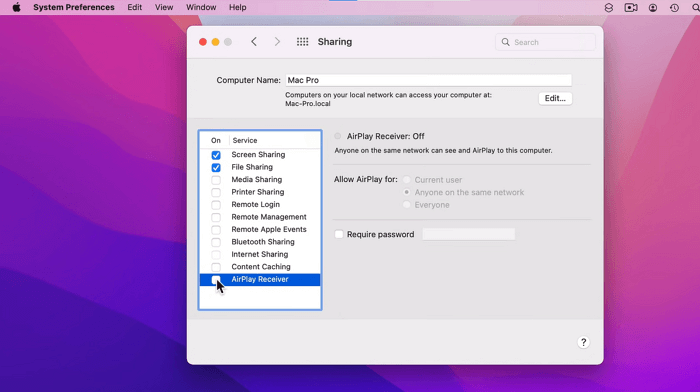
Uncheck the “AirPlay Receiver” box
Step 2. If the AirPlay Receiver is off, check the box to turn it on.
Step 3. Under “Allow the following users to AirPlay,” select “Current User or Anyone in the same network.”
Step 4. If prompted, enter a password to enable AirPlay with your MacBook.
Step 5. If your Mac shows an AirPlay verification code, enter the code on your iPhone when prompted.
| Pros |
Cons |
| Free to use, no purchase required |
Sound quality may sometimes degrade |
| Operates over longer distances than Bluetooth |
AirPlay Mirroring is limited to newer Apple devices |
| Easy and convenient to set up |
Way 3. Mirroring iPhone to MacBook without WiFi by Bluetooth – AirServer
AirServer allows you to mirror your iPhone to a MacBook without Wi-Fi using Bluetooth. This method provides a simple and wireless way to connect, making it ideal for scenarios where Wi-Fi is unavailable. Bluetooth mirroring is very useful if you’d like to share your screen in real time since it can do this efficiently without lagging. AirServer has a powerful quad-core processor enables it to deliver high-definition videos and low latency, enhancing the streaming quality. It also supports multi-device mirroring, allowing you to connect multiple devices at a given instance. Here’s how to airplay iPhone to MacBook without WiFi using Bluetooth:
Step 1. Install AirServer on your MacBook.
Step 2. Activate Bluetooth on your MacBook and iPhone.
Step 3. Navigate to “Preferences > Bluetooth” on your Mac and find your iPhone.
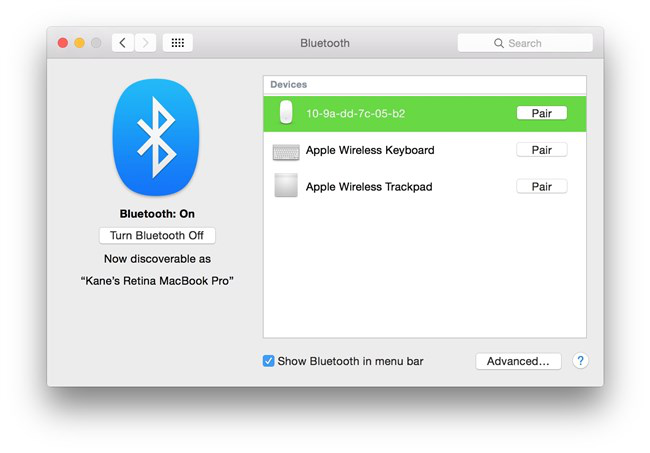
Turn on Bluetooth on your Mac
Step 4. Select your iPhone from the list and click on “Connect.”
Step 5. Open Control Center on your iPhone and tap on “Screen Mirroring”. Choose your Mac device to mirror screen.
| Pros |
Cons |
| Unlocks additional audio features not available with AirPlay |
Limited by Bluetooth range |
| Supports AirPlay mirroring |
May have slower performance compared to Wi-Fi |
| Easy to use with Bluetooth-enabled devices |
Way 4. Mirroring iPhone to MacBook without WiFi by QuickTime
QuickTime provides a basic approach to screen mirroring an iPhone to a MacBook without Wi-Fi through a cable connection. It is known that this method creates a stable and reliable connection, so the users will not experience any lag in the video stream. QuickTime’s other handy feature is screen capturing, so you can record whatever is happening on your iPhone screen right on your MacBook. This method is especially useful for presentations or tutorials, offering clear audio and smooth playback with minimal setup. Check out the steps below for this method:
Step 1. Use a USB connection to link your iPhone to your MacBook.
Step 2. Launch QuickTime on your MacBook.
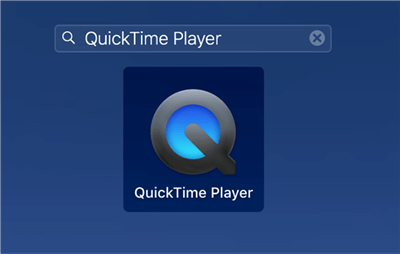
Access QuickTime Player on the Mac
Step 3. After clicking on “File” in the menu bar, choose “New Movie Recording.”
Step 4. Select your iPhone from the device list that appears. Now, your MacBook will mirror the display of your iPhone.
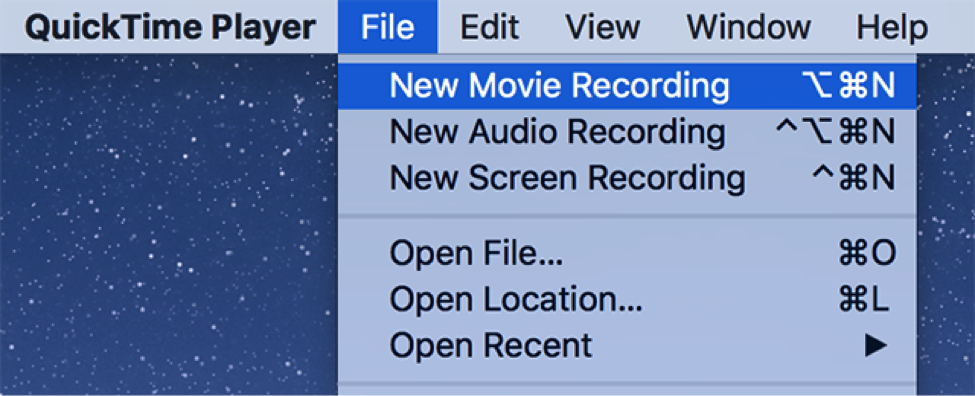
Start New Recording in QuickTime Player
| Pros |
Cons |
| Provides a stable connection |
Requires a USB cable |
| Ensures high-quality video |
Limited to Mac users only |
| Allows for screen recording |
Does not support wireless mirroring |
[Pro Tips] How to AirPlay from iPhone/iPad to Windows PC without WiFi
AnyMiro is a multi-functional application that allows users to mirror an iPhone or iPad screen to a Windows PC without connecting via Wi-Fi. It enables you to cast your iOS device screen to your PC effortlessly, making it convenient to work, stream, or game with mirrored content. Due to the tool’s intuitive interface, you can install and get the basic configuration done within a few simple steps. To use this method:
Step 1. Launch AnyMiro on your Windows PC and select “iOS/iPadOS” to get started.

Mirror iPhone to Computer
Step 2. Select the “Wi-Fi connection” mode.

Mirror iOS to Computer via WiFi
Step 3. Ensure the Windows PC and iPhone are linked to the same wireless network. Open the Settings app on both devices to examine the network name.
Step 4. On your iPhone, swipe down to open the “Control Center,” tap “Screen Mirroring,” and select “AnyMiro_[PC Name]” from the list of available devices.
Step 5. Your iPhone screen will now be mirrored on your Windows PC, allowing you to enjoy a smooth viewing experience.
FAQs on Mirroring iPhone to Mac Without WiFi
When should you mirror iPhone to Mac without WiFi?
Mirror your iPhone when Wi-Fi is slow or not available. It is useful when you need internet access to share presentations, movies, or pictures straight from your Mac.
How to AirPlay from iPhone/iPad to Smart TV without WiFi?
Use a direct cable connection or compatible app to AirPlay to a Smart TV without Wi-Fi. This allows you to connect directly to the TV without needing a network.
Which screen mirroring option is safest?
Screen mirroring is safe if you use trusted apps and secure connections. To protect your information, we recommend using AnyMiro for sharing with known devices.
Final Words
This article examined different ways to mirror your iPhone to a Mac without Wi-Fi. We discussed methods like QuickTime, Bluetooth, and apps such as AnyMiro. Each option has its benefits, letting you easily share your screen for videos, presentations, or gaming. By following the simple steps, you can enjoy a smooth mirroring experience even without a network. However, if you want to achieve optimal performance, we suggest you use AnyMiro since it is very simple and effective regarding screen mirroring.
Joy Taylor
Senior writer of the iMobie team as well as an Apple fan, love to help more users solve various types of iOS & Android-related issues.
Screenify
AnyEnhancer
FocuSee
Vozard
AnyMiro
AnyMirror









